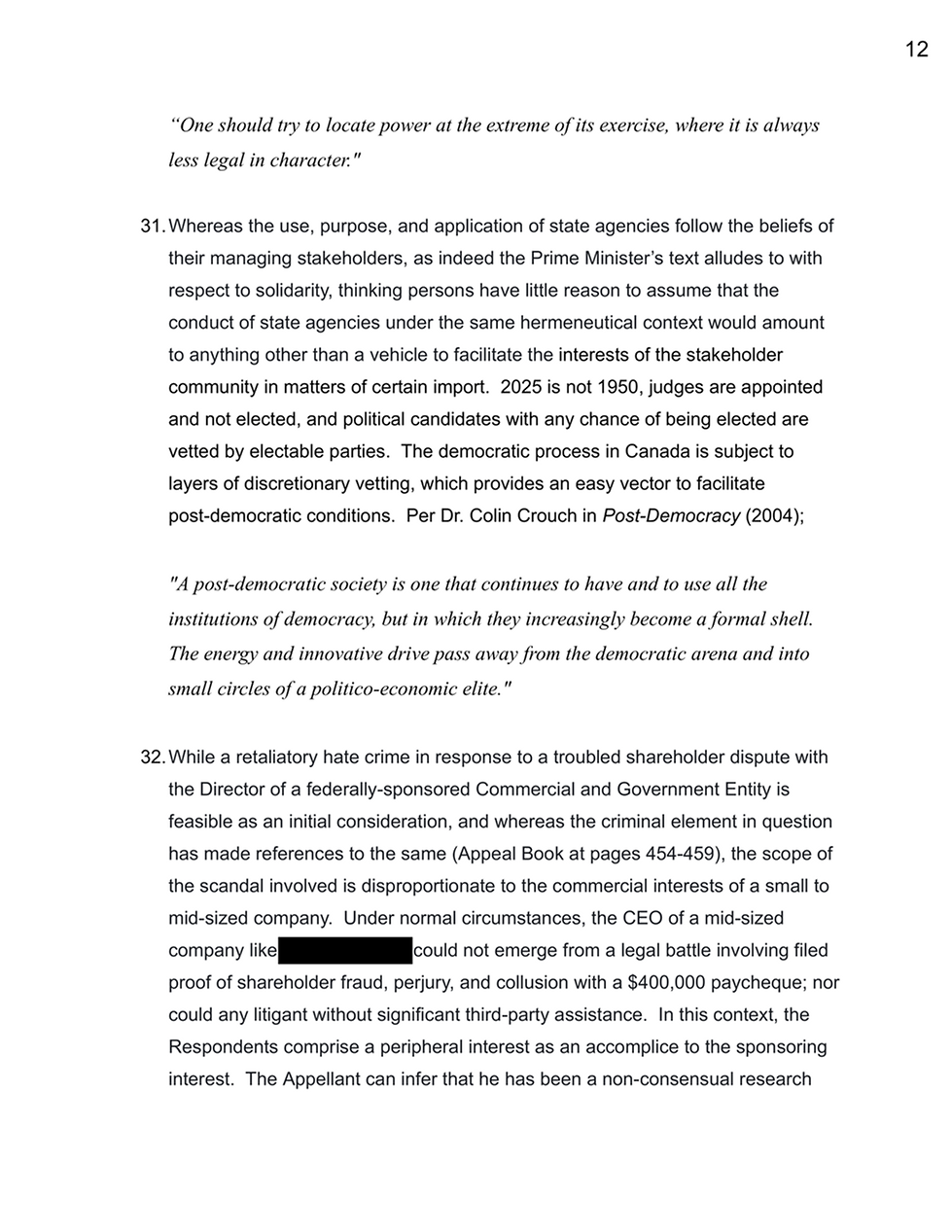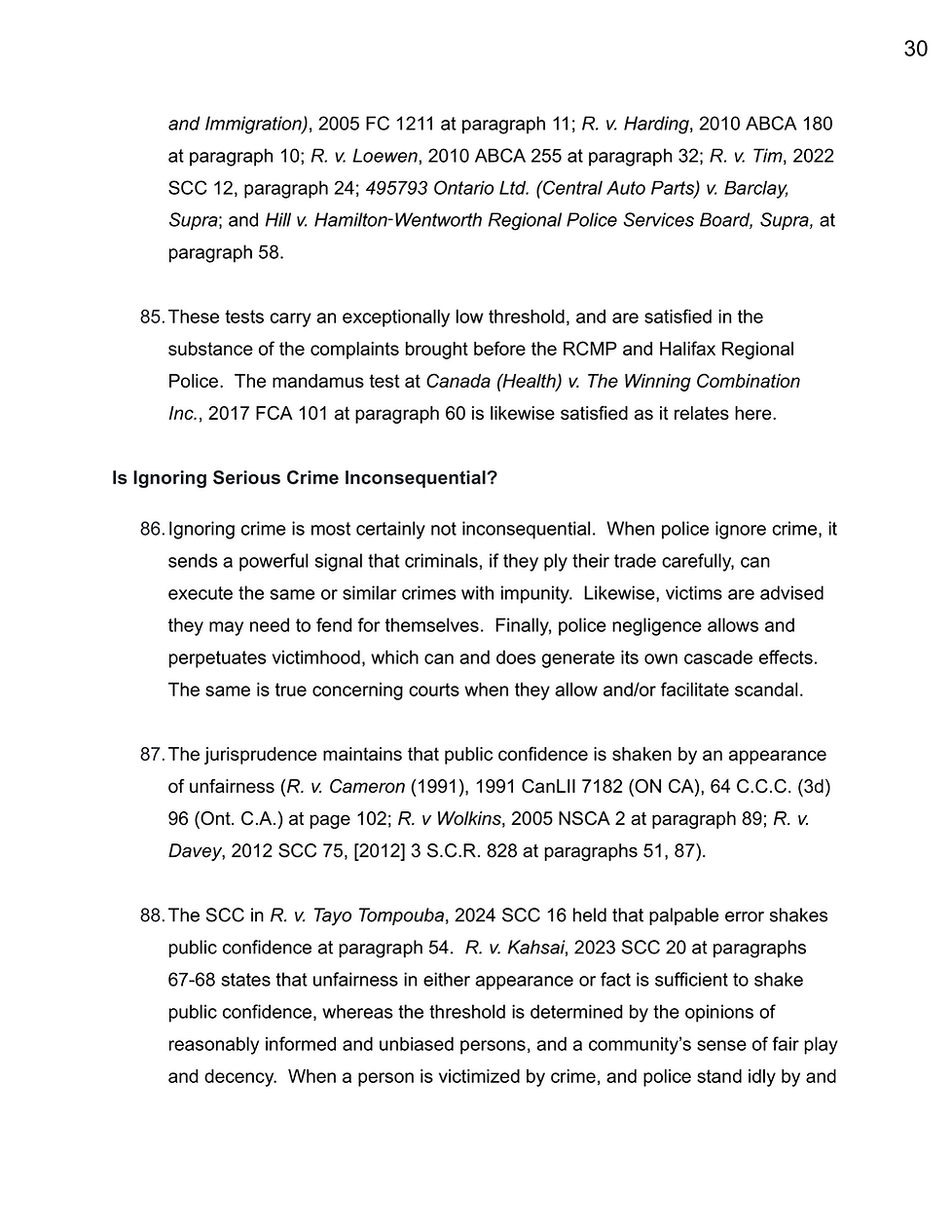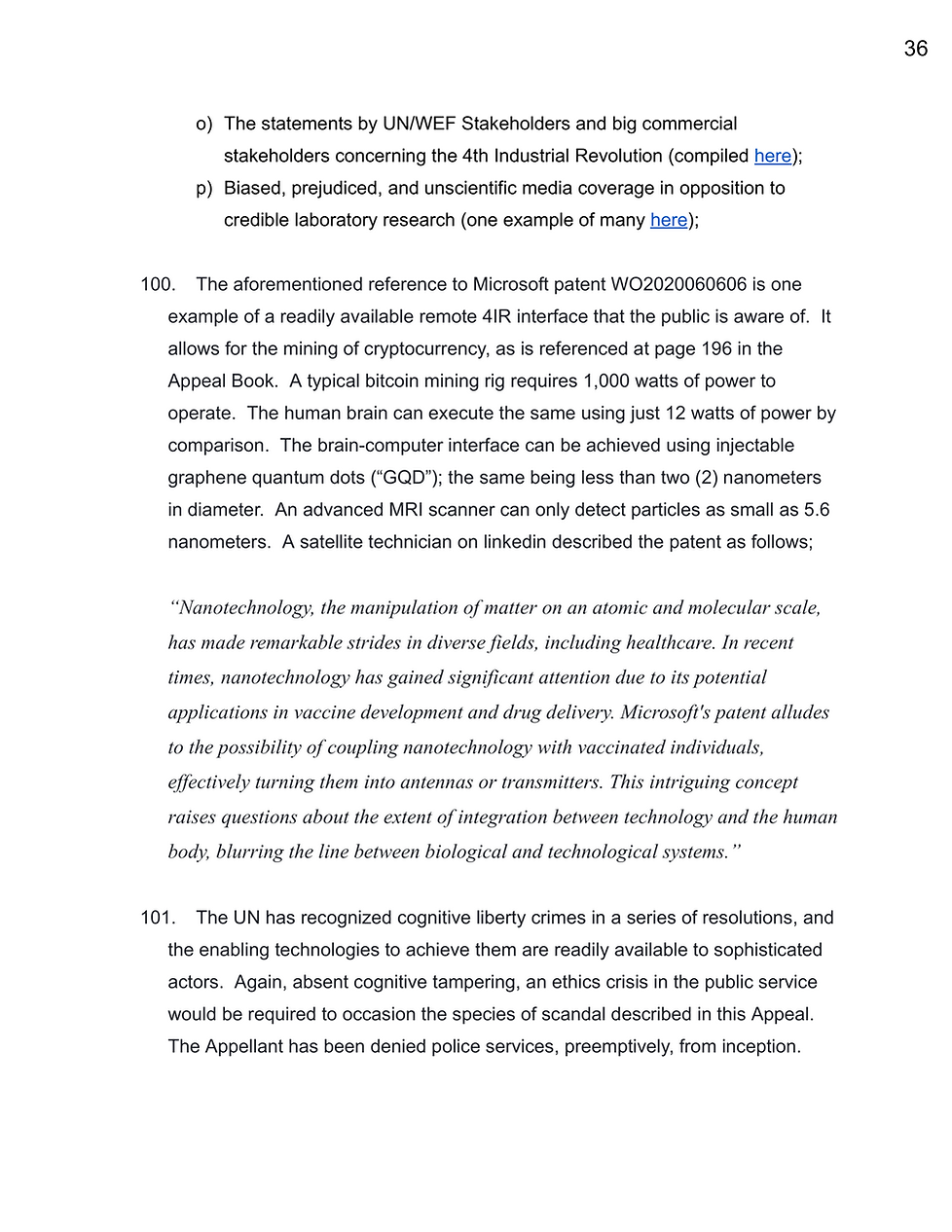Crimes Against Humanity and War Crimes Act (S.C. 2000, c. 24) [Link]

Four Briefs and a Factum
A Supplement to the Litigation & Enforcement Page Contents
June 8th, 2025
Concerning the Enforcement of a Scandal
The Commercial & Government Entity (“CAGE”) involved in the scandal detailed on this website is intent on incarcerating me again concerning the enforcement of the retainer fee felony detailed (here). If you are a first-time reader, cost certificates amounting to 737.7 billable hours (like the passenger jet) were signed in consideration of nine (9) short-chambers hearings that were each less than 60 minutes in duration as is shown in the aforementioned link, with the CAGE affidavits showing the service line items. The CAGE retainer fees yield an 89x multiplier compared to customary fees germane to the scope ($376,201.97 vs. $4,500), featuring seven (7) lawyers and two (2) paralegals assigned to overlapping tasks at egregiously inflated time blocks. Paragraph 10 of the CAGE Affidavit in that same link indicates that the entirety of costs are due to the billable hours shown. The BC Supreme Court clerk's notes at the same link show the actual time and scope of the hearings, as measured against the CAGE Affidavits. It is theft in the clearest of terms, and the sworn evidence is sourced directly from the CAGE and the BC court.
Although I was denied customary corrective recourse concerning the above, it is equally compelling that it had unfolded in the first place. Smart readers will recognize that certain characteristics are required to yield an event of that magnitude. The legal test in Bradshaw Construction Ltd. v. Bank of Nova Scotia (1991), 54 B.C.L.R. (2d) 309 (S.C.), paragraph 44 states, "Special costs are fees a reasonable client would pay a reasonably competent solicitor to do the work described in the bill". The analysis is easy; a reasonable litigant would not agree to a $400,000 retainer to support nine (9) short court hearings which are usually tabulated at $500 apiece. A reputable law firm (in this case, an AM 100 law firm), would not propose that retainer. An unbiased and reasonable judge would not certify nor enforce it. Finally, a scandal like that is not in any way likely to be rejected at the Supreme Court of Canada ("SCC"), by way of Iacobucci J.’s docket entry test in R. v. C.P., 2021 SCC 19 at para. 137. Yet, all of those boxes were ticked. To orchestrate that outcome, each of the persons and entities involved would have required assurances from a stakeholder or stakeholders capable of providing them. That likewise requires some measure of oversight concerning the conduct of state institutions. An investigator's next question would concern the "who" and the "why". My Testimony and Q/A pages explore this further.
Those costs were certified in the wake of a miscarriage of justice in BCSC files S-220956 & S-229680 (the totality resulting in 9 short hearings), as is detailed here & here, with the enforcement proceedings on this page and here. The proceedings were beset by (and preceded by) related criminal interference (here & here, likewise described in Sheridan et al., 2020). The mode of criminal mischief involves the use of sophisticated surveillance mechanisms that would require the support of state actors (see UN Special Rapporteur report here, and UN Resolution A/HRC/57/61 concerning neurotech crimes here). Engagement with police, which includes live audio recordings and FOIPOP reports, are shown here & here. I have been consistently turned aside by police, and appellate court venues had replicated the same errors made by their lower court counterparts. I was denied fiduciary legal support in preemptive capacities (here). My retained legal counsel in the initial shareholder dispute is in fact implicated in collusion, shown (here) alongside proof of a scandal concerning CAGE shareholders. All of this happened.
My first incarceration, during August 2024, is noted (here). The arresting sheriffs advised I was detained for online content the CAGE wanted removed. While the exact content was not specified, they had presumably referred to this website, as I do not own any other online content, and I am not on social media. I was beaten by unknown inmates within 40 minutes of entry, deprived of food for over a day, was splashed with urine, and was counselled to commit suicide before being transferred to a different detention block. A NS Legal Aid representative, without agreeing to provide access to counsel (here), echoed the Sheriff's request to explore a removal of web content, in exchange for a shortened sentence. In the weeks that followed, conditions at the facility elicited an autoimmune response linked to my four interrelated GI diseases, as is described at the same link.
Whereas the effects and substance of the scandal detailed on this website remain unaddressed despite being proven across many angles, my legal defense as a Citizen resides in a defense of necessity, in resisting unconstitutional effects facilitated through weaponized authorities without any remaining procedural recourse. The second brief below, using a "decision tree" approach, explores case law in matters where appellate venues nonetheless fail to correct serious problems, as well as circumstances of systemic bias and/or corruption, and the issue of an increasingly post-democratic culture in Canadian courts (here, here, here, & here). Reasonable persons do not consent to theft, regardless of the means. Per the case law in Perka et al. v. The Queen, 1984 CarswellBC 2518, at paragraph 96;
“This, however, is distinguishable from the situation in which punishment cannot on any grounds be justified, such as, the situation where a person has acted in order to save his own life. As Kant indicates, although the law must refrain from asserting that conduct which otherwise constitutes an offence is rightful if done for the sake of self-preservation, there is no punishment which could conceivably be appropriate to the accused's act. As such, the actor falling within the Chief Justice's category of "normative involuntariness" is excused, not because there is no instrumental ground on which to justify his punishment, but because no purpose inherent to criminal liability and punishment — i.e., the setting right of a wrongful act — can be accomplished for an act which no rational person would avoid.”
A defense of necessity as outlined in Perka v. The Queen, [1984] 2 S.C.R. 232 ("Perka") may apply as an excuse and as a justification.
Per Wilson J. in Perka at pages 270 & 279;
"As Dickson J. points out, although the necessity defence has engendered a significant amount of judicial and scholarly debate, it remains a somewhat elusive concept. It is, however, clear that justification and excuse are conceptually quite distinct and that any elucidation of a principled basis for the defence of necessity must be grounded in one or the other. Turning first to the category of excuse, the concept of “normative involuntariness” stressed in the reasons of Dickson J. may, on one reading, be said to fit squarely within the framework of an individualized plea which Professor Fletcher indicates characterizes all claims of excusability. The notional involuntariness of the action is assessed in the context of the accused’s particular situation. The court must ask not only whether the offensive act accompanied by the requisite culpable mental state (i.e. intention, recklessness, etc.) has been established by the prosecution, but whether or not the accused acted so as to attract society’s moral outrage. [...] Where the defence of necessity is invoked as a justification the issue is simply whether the accused was right in pursuing the course of behaviour giving rise to the charge."
The defense at Syndicat Northcrest v. Amselem, [2004] 2 S.C.R. 551, 2004 SCC 47 further applies with respect to the section 2(a) of the Charter of Rights and Freedoms as it pertains to my core beliefs. Per Iacobucci J. at paragraphs 40 & 41;
"A truly free society is one which can accommodate a wide variety of beliefs, diversity of tastes and pursuits, customs and codes of conduct. A free society is one which aims at equality with respect to the enjoyment of fundamental freedoms and I say this without any reliance upon s. 15 of the Charter. Freedom must surely be founded in respect for the inherent dignity and the inviolable rights of the human person. The essence of the concept of freedom of religion is the right to entertain such religious beliefs as a person chooses, the right to declare religious beliefs openly and without fear of hindrance or reprisal, and the right to manifest religious belief by worship and practice or by teaching and dissemination. But the concept means more than that. Freedom means that no one is to be forced to act in a way contrary to his beliefs or his conscience. [...] Similarly, in R. v. Edwards Books and Art Ltd., [1986] 2 S.C.R. 713, at p. 759, Dickson C.J. stated that the purpose of s. 2(a) is to ensure that society does not interfere with profoundly personal beliefs that govern one’s perception of oneself, humankind, nature, and, in some cases, a higher or different order of being. These beliefs, in turn, govern one’s conduct and practices. [Emphasis added.]"
As it applies to me in consideration of the foregoing, the Catechism of the Catholic Church notes at section 2242;
"The citizen is obliged in conscience not to follow the directives of civil authorities when they are contrary to the demands of the moral order, to the fundamental rights of persons or the teachings of the Gospel. Refusing obedience to civil authorities, when their demands are contrary to those of an upright conscience, finds its justification in the distinction between serving God and serving the political community, "Render therefore to Caesar the things that are Caesar's, and to God the things that are God's; We must obey God rather than men". When citizens are under the oppression of a public authority which oversteps its competence, they should still not refuse to give or to do what is objectively demanded of them by the common good; but it is legitimate for them to defend their own rights and those of their fellow citizens against the abuse of this authority within the limits of the natural law and the Law of the Gospel."
Legal tests concerning the public interest in fighting crime are located at R. v. Beaudry, [2007] 1 S.C.R. 190, 2007 SCC 5, at paragraph 35; and Hill v. Hamilton‑Wentworth Regional Police Services Board, [2007] 3 S.C.R. 129, 2007 SCC 41, at paragraphs 1, 36, 37, 44, & 140. These tests underscore the fact that public confidence is most certainly shaken in the absence of reasonable police response to crime, including events that “might be actionable” under the Canadian Criminal Code (495793 Ontario Ltd. (Central Auto Parts) v. Barclay, 2016 ONCA 656 @ paragraph 51), and the appearance of unfairness (R. v. Cameron (1991), 1991 CanLII 7182 (ON CA), 64 C.C.C. (3d) 96 (Ont. C.A.) at page 102; R. v Wolkins, 2005 NSCA 2 at paragraph 89; R. v. Davey, 2012 SCC 75, [2012] 3 S.C.R. 828 at paragraphs 51, 87). An expanded overview of these legal tests are shown here & here. Collusive frameworks may be applied to individual victims, but they are never developed for individual victims.
The Briefs:
-
A Response Brief concerning a motion filed by the CAGE to seal the appeal file. The CAGE asserts a public interest in judicial comity (horizontal stare decisis), to the extent that other judges should replicate unconstitutional sealing orders made by their peers [CLICK];
-
A Brief in support of a motion to stay the contempt punishment hearing (which could land me in jail), and an injunction to prevent the ongoing enforcement of the retainer fee felony [CLICK];
-
A 3-page reply Brief supplemental to the above brief, and a court transcript excerpt from the corresponding hearing [CLICK];
-
A detailed Case Law Brief summarizing the enforcement proceedings in NS, and a researched examination of the Perka defense of necessity as it would apply to weaponized authority and post-democratic conditions [CLICK];
-
An easy-to-read summary Factum presenting the key components of the scandal, beginning with neurotech crime [CLICK].
Further details concerning the proceedings these materials are filed in can be found [HERE].
R. v Wolkins, 2005 NSCA 2 at paragraph 89;
"The clearest example is the conviction of an innocent person. There can be no greater miscarriage of justice. Beyond that, it is much easier to give examples than a definition; there can be no “strict formula .. to determine whether a miscarriage of justice has occurred”: R. v. Khan, 2001 SCC 86 (CanLII), [2001] 3 S.C.R. 823 per LeBel, J. at para. 74. However, the courts have generally grouped miscarriages of justice under two headings. The first is concerned with whether the trial was fair in fact. A conviction entered after an unfair trial is in general a miscarriage of justice: Fanjoy supra; R. v. Morrissey (1995), C.C.C. (3d) 193 (Ont. C.A.) at 220 - 221. The second is concerned with the integrity of the administration of justice. A miscarriage of justice may be found where anything happens in the course of a trial, including the appearance of unfairness, which is so serious that it shakes public confidence in the administration of justice: R. v. Cameron (1991), 1991 CanLII 7182 (ON CA), 64 C.C.C. (3d) 96 (Ont. C.A.) at 102; leave to appeal ref’d [1991] 3 S.C.R. x."
Opposing Unconstitutional Censorship
Confidentiality Motion Response Brief: Judicial Comity Cannot Upend the Constitution


![May 22nd 2025 Brief NSCA 542305 [Open Court][Filed] rgc_3.png](https://static.wixstatic.com/media/5b4df5_d57473ee84d848f09c19a6e578638e24~mv2.png/v1/fill/w_979,h_1265,al_c,q_90,usm_0.66_1.00_0.01,enc_avif,quality_auto/May%2022nd%202025%20Brief%20NSCA%20542305%20%5BOpen%20Court%5D%5BFiled%5D%20rgc_3.png)













Opposing the Enforcement of a Felony
A Motion for Stay & Injunction in Consideration of the Jurisprudence
This Decision-Tree Brief Presents a Researched Approach to Various Choice Options.
The Appellate motion judge advised that she would not comment on its contents. Detailed commentary concerning the decision of the motion can be found (here). It is noted that the court was within its jurisdiction to grant the motion under NS Rule 90.37(2) and 90.48(1)(e).
























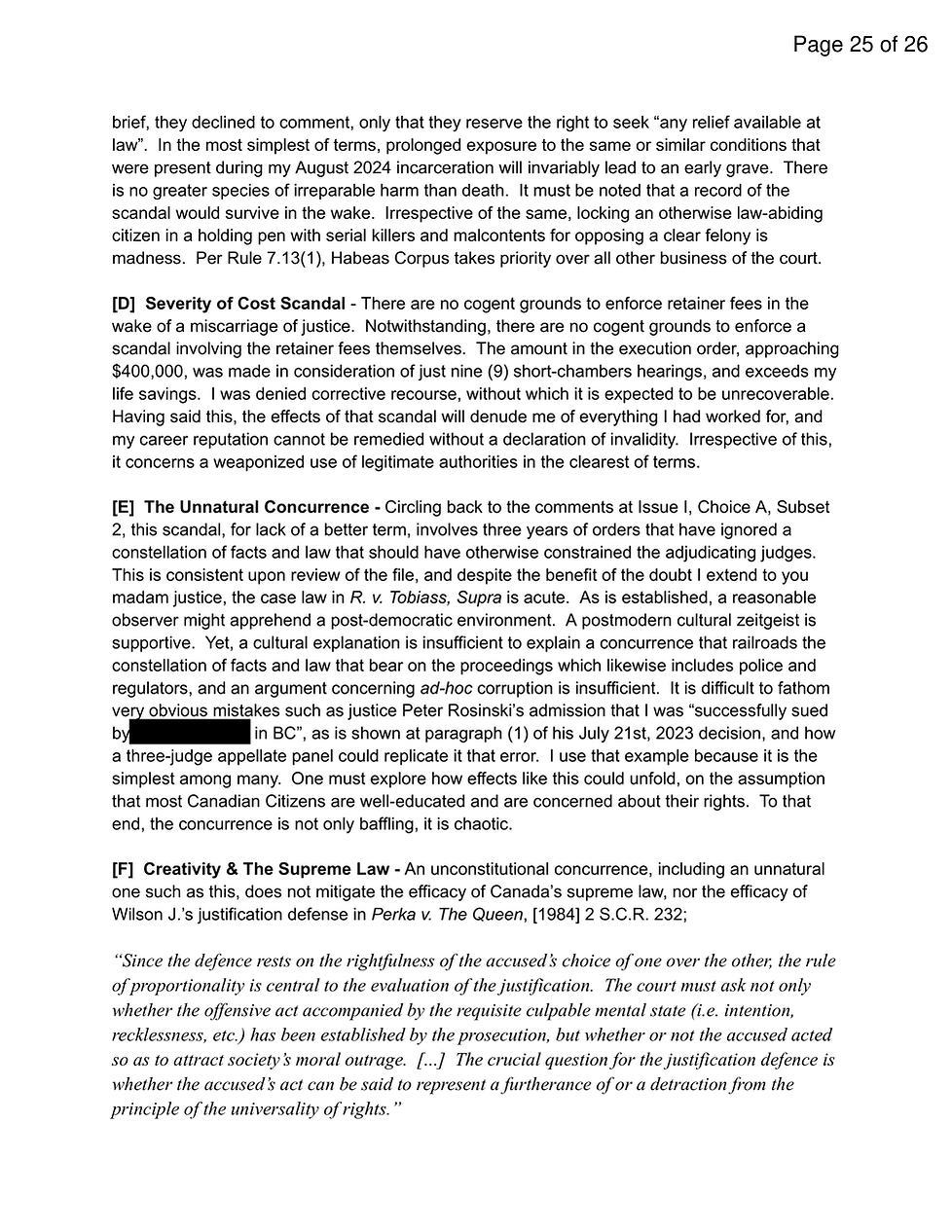

A Three-Page Rebuttal Brief Focusing on Key Factual Issues, Supplemental to the Above.



A Transcript Excerpt From the Corresponding Hearing Before NSCA Justice Anne S. Derrick
Read This Transcript Carefully.
The motion judge implied that she was excused from considering the issues in the scandal because she did not have the jurisdiction to correct them. Her comments present a false dilemma (Canada (Minister of Citizenship and Immigration) v. Vavilov, 2019 SCC 65, [2019] 4 S.C.R. 653 at paragraph 104). A judge is never permitted to ignore relevant contextual evidence in a motion that is nonetheless expected to impact its decision (Colburne v. Frank, 1995 NSCA 110 at paragraph 9; Charkaoui v. Canada (Citizenship and Immigration), [2007] 1 S.C.R. 350, 2007 SCC 9 at paragraph 48; Coast Foundation v. Currie, 2003 BCSC 1781 at paragraphs 13 and 15; inter alia). It was within her jurisdiction to order a stay to prevent the enforcement of a felony (R. v. Babos, 2014 SCC 16, [2014] 1 S.C.R. 309 at paragraphs 76-78; Canada (Minister of Citizenship and Immigration) v. Tobiass, [1997] 3 S.C.R. 391 at paragraphs 91 & 110; Carey v. Laiken, 2015 SCC 17, [2015] 2 S.C.R. 79 at paragraphs 36-37; and United States of America v. Cobb, [2001] 1 S.C.R. 587, 2001 SCC 19; inter alia). The enforcement court hearings are further detailed (here).
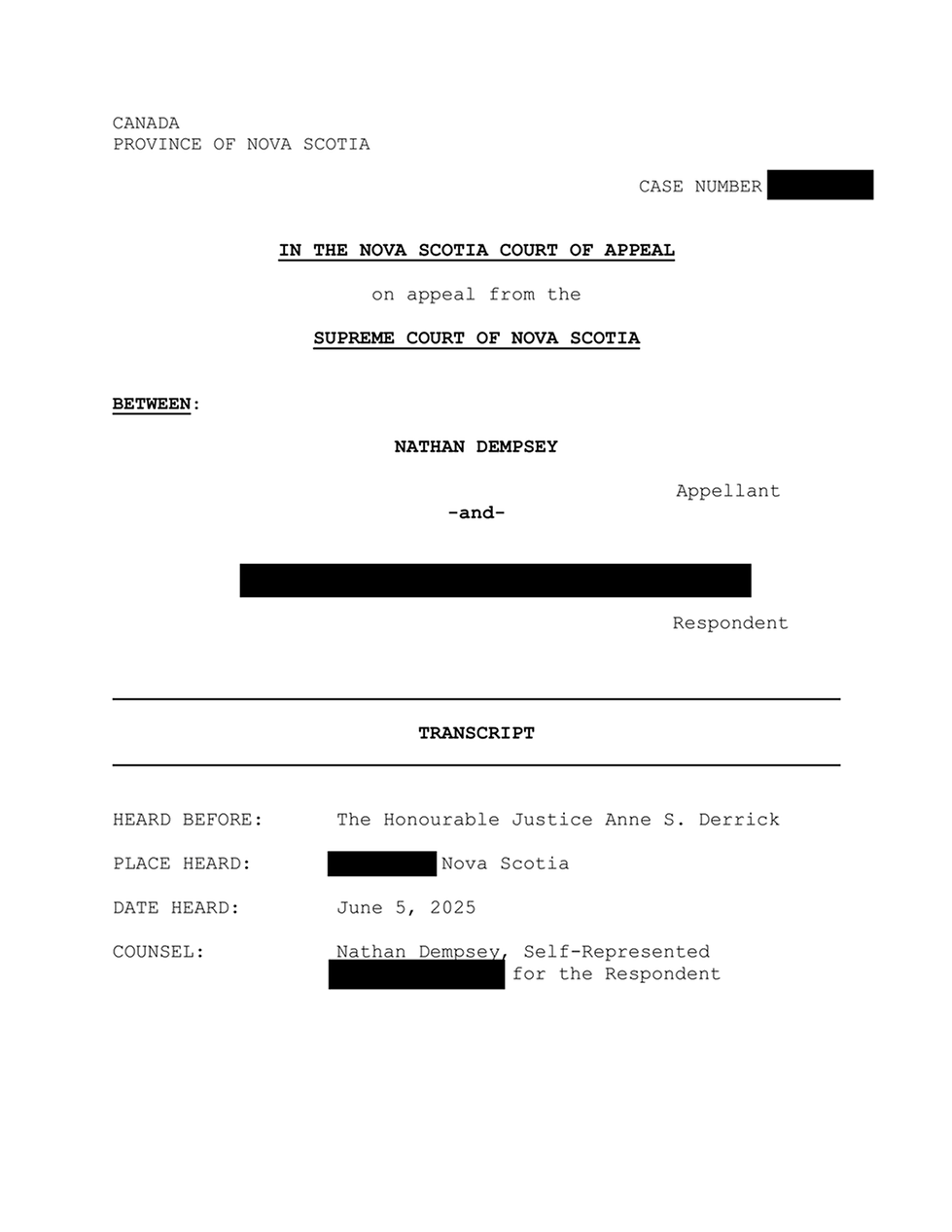

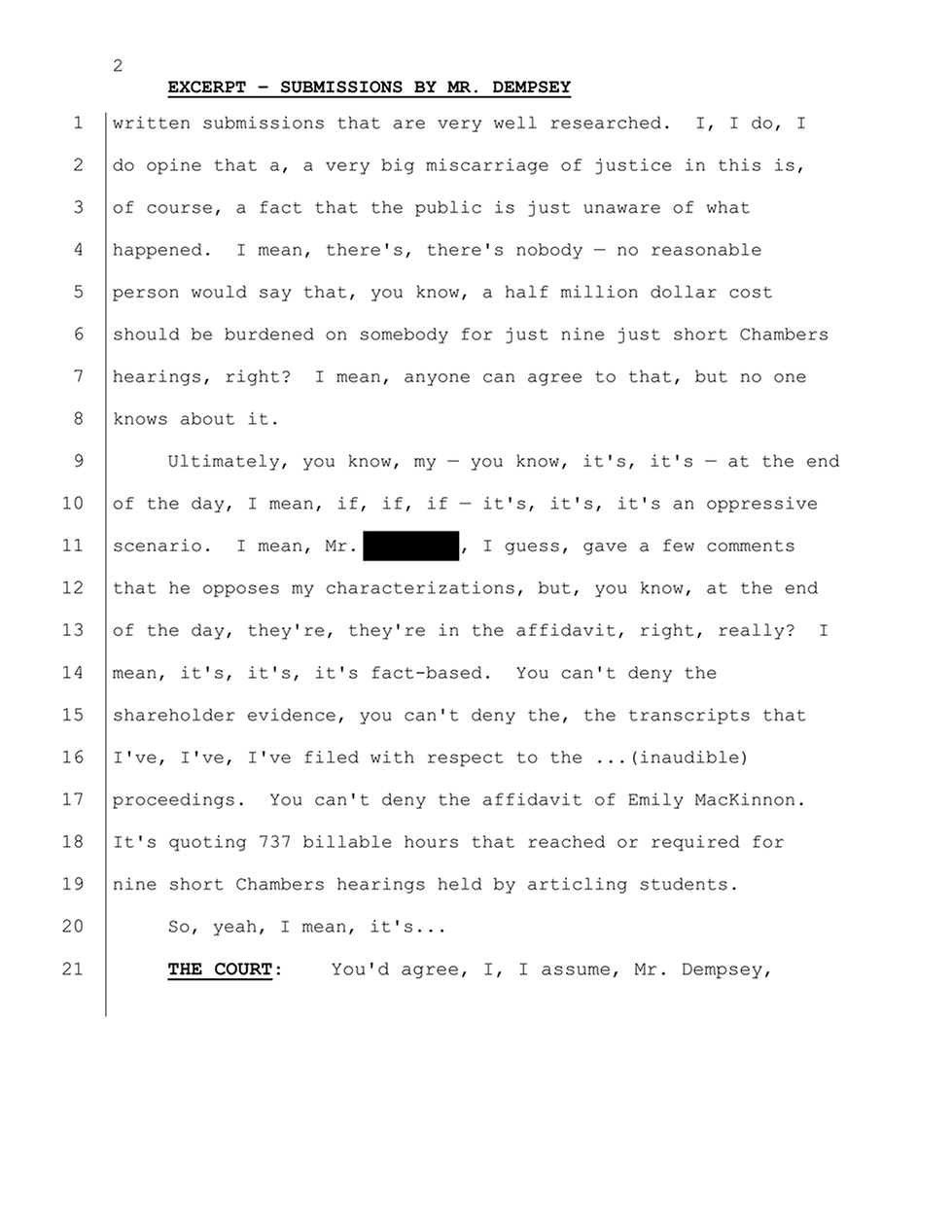
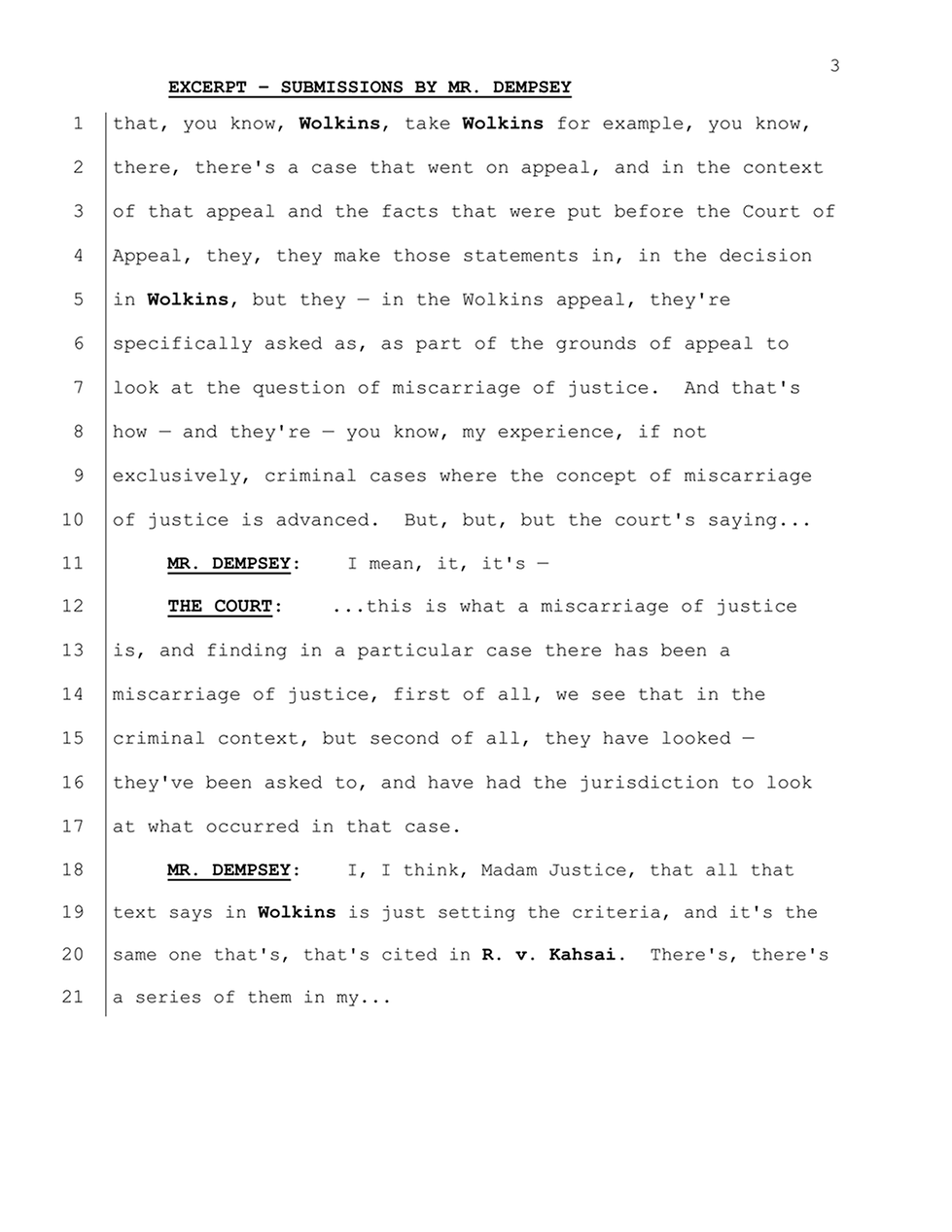









A Brief Concerning the Enforcement Proceedings & a Researched Application of the Perka Defense.
My Motion to Stay the Lower Court Contempt Proceedings Fell on Deaf Ears.
The civil contempt order, still under appeal but not scheduled until October 3rd, 2025, still has an unscheduled penalty hearing. The following brief contains the most comprehensive exposition of the Perka defense as it applies to the scandal.










![Perka v. The Queen, [1984] 2 S.C.R. 232](https://static.wixstatic.com/media/5b4df5_6eb85d9e8da24d03b8597c5eac8fc37f~mv2.png/v1/fill/w_978,h_1265,al_c,q_90,usm_0.66_1.00_0.01,enc_avif,quality_auto/RGC%20June%2023%202025%20Brief%20NSSC%20529459%20%5BFiled%5D_11.png)
![Perka v. The Queen, [1984] 2 S.C.R. 232](https://static.wixstatic.com/media/5b4df5_eb149ef2221d4ed3842774b27b62783c~mv2.png/v1/fill/w_978,h_1265,al_c,q_90,usm_0.66_1.00_0.01,enc_avif,quality_auto/RGC%20June%2023%202025%20Brief%20NSSC%20529459%20%5BFiled%5D_12.png)
![Perka v. The Queen, [1984] 2 S.C.R. 232](https://static.wixstatic.com/media/5b4df5_7dbc1eaccd7144c0b366eabadf120766~mv2.png/v1/fill/w_978,h_1265,al_c,q_90,usm_0.66_1.00_0.01,enc_avif,quality_auto/RGC%20June%2023%202025%20Brief%20NSSC%20529459%20%5BFiled%5D_13.png)
![Perka v. The Queen, [1984] 2 S.C.R. 232](https://static.wixstatic.com/media/5b4df5_c85abd53d99c4eceaccf4c398801abd8~mv2.png/v1/fill/w_978,h_1266,al_c,q_90,usm_0.66_1.00_0.01,enc_avif,quality_auto/RGC%20June%2023%202025%20Brief%20NSSC%20529459%20%5BFiled%5D_14.png)
![Perka v. The Queen, [1984] 2 S.C.R. 232](https://static.wixstatic.com/media/5b4df5_8d0bf460326747dc8f6ebdbe8b5cca33~mv2.png/v1/fill/w_978,h_1266,al_c,q_90,usm_0.66_1.00_0.01,enc_avif,quality_auto/RGC%20June%2023%202025%20Brief%20NSSC%20529459%20%5BFiled%5D_15.png)
![Perka v. The Queen, [1984] 2 S.C.R. 232](https://static.wixstatic.com/media/5b4df5_25fa12205a354a3e9b1e6eb2fa335d30~mv2.png/v1/fill/w_978,h_1265,al_c,q_90,usm_0.66_1.00_0.01,enc_avif,quality_auto/RGC%20June%2023%202025%20Brief%20NSSC%20529459%20%5BFiled%5D_16.png)
![Perka v. The Queen, [1984] 2 S.C.R. 232](https://static.wixstatic.com/media/5b4df5_bd42f499fc3e4ec09d6c4c682dacbe68~mv2.png/v1/fill/w_978,h_1266,al_c,q_90,usm_0.66_1.00_0.01,enc_avif,quality_auto/RGC%20June%2023%202025%20Brief%20NSSC%20529459%20%5BFiled%5D_17.png)
![Perka v. The Queen, [1984] 2 S.C.R. 232](https://static.wixstatic.com/media/5b4df5_766beb80f01c4efc81ac64be29d22445~mv2.png/v1/fill/w_978,h_1266,al_c,q_90,usm_0.66_1.00_0.01,enc_avif,quality_auto/RGC%20June%2023%202025%20Brief%20NSSC%20529459%20%5BFiled%5D_18.png)
![Perka v. The Queen, [1984] 2 S.C.R. 232](https://static.wixstatic.com/media/5b4df5_98bced46c0c64e5196a19ce61ec86b96~mv2.png/v1/fill/w_978,h_1265,al_c,q_90,usm_0.66_1.00_0.01,enc_avif,quality_auto/RGC%20June%2023%202025%20Brief%20NSSC%20529459%20%5BFiled%5D_19.png)
![Perka v. The Queen, [1984] 2 S.C.R. 232](https://static.wixstatic.com/media/5b4df5_2ee10d286daf4615a06e3e9bd4c1c9f6~mv2.png/v1/fill/w_978,h_1266,al_c,q_90,usm_0.66_1.00_0.01,enc_avif,quality_auto/RGC%20June%2023%202025%20Brief%20NSSC%20529459%20%5BFiled%5D_20.png)
![Perka v. The Queen, [1984] 2 S.C.R. 232](https://static.wixstatic.com/media/5b4df5_aab273c5c9914aa5aad914af3b8b429c~mv2.png/v1/fill/w_978,h_1265,al_c,q_90,usm_0.66_1.00_0.01,enc_avif,quality_auto/RGC%20June%2023%202025%20Brief%20NSSC%20529459%20%5BFiled%5D_21.png)
![Perka v. The Queen, [1984] 2 S.C.R. 232](https://static.wixstatic.com/media/5b4df5_1f47241f5523412fa37d128d8a4b12ac~mv2.png/v1/fill/w_978,h_1265,al_c,q_90,usm_0.66_1.00_0.01,enc_avif,quality_auto/RGC%20June%2023%202025%20Brief%20NSSC%20529459%20%5BFiled%5D_22.png)
![Perka v. The Queen, [1984] 2 S.C.R. 232](https://static.wixstatic.com/media/5b4df5_50f4e9d91d3e4b4ebbcd4a2a31a80c7c~mv2.png/v1/fill/w_979,h_1267,al_c,q_90,usm_0.66_1.00_0.01,enc_avif,quality_auto/RGC%20June%2023%202025%20Brief%20NSSC%20529459%20%5BFiled%5D_23.png)
![Perka v. The Queen, [1984] 2 S.C.R. 232](https://static.wixstatic.com/media/5b4df5_4afb7c8d35714b14a744ecd1f8c34385~mv2.png/v1/fill/w_978,h_1266,al_c,q_90,usm_0.66_1.00_0.01,enc_avif,quality_auto/RGC%20June%2023%202025%20Brief%20NSSC%20529459%20%5BFiled%5D_24.png)
![Perka v. The Queen, [1984] 2 S.C.R. 232](https://static.wixstatic.com/media/5b4df5_979882a148ac43669749da7638e171b5~mv2.png/v1/fill/w_979,h_1267,al_c,q_90,usm_0.66_1.00_0.01,enc_avif,quality_auto/RGC%20June%2023%202025%20Brief%20NSSC%20529459%20%5BFiled%5D_25.png)
![Perka v. The Queen, [1984] 2 S.C.R. 232](https://static.wixstatic.com/media/5b4df5_83c796c26cb3468993c2856eea090bef~mv2.png/v1/fill/w_978,h_1266,al_c,q_90,usm_0.66_1.00_0.01,enc_avif,quality_auto/RGC%20June%2023%202025%20Brief%20NSSC%20529459%20%5BFiled%5D_26.png)
A Summary Factum
4IR Neurotech Crime | AI-Assisted Covert Torture | the Court Scandal | Police Cover-Up
Concerning the Use of Recognized Public Institutions to Facilitate Private Criminal Interests
This Factum, presented in an easy-to-read font, presents the basic issues of the scandal.












